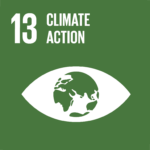First in Southeast Asia, The Philippines government has urged businesses to reduce plastic usage through regulation, with financial penalties for non-compliance.
For decades, the Philippines has faced a mounting crisis: as one of the world’s largest contributors to ocean plastic pollution, the island nation has struggled to keep up with a relentless tide of waste. Now, in a bid to turn the tide, the government has implemented stringent regulations that make large corporations responsible for reducing plastic pollution. This unprecedented approach – a first in Southeast Asia – marks a pivotal step in addressing the country’s urgent environmental crisis.
RELEVANT SUSTAINABLE GOALS



Extended Producer Responsibility: A Landmark Legislation
The Philippines’ Extended Producer Responsibility (EPR) law, enacted in 2023, is a bold experiment that aims to achieve “plastic neutrality” by holding companies financially responsible for their plastic footprint. This law, which is both promising and challenging in execution, serves as a testing ground for measures that may be integrated into a global treaty to combat plastic pollution, set for negotiation in 2024.
Under the EPR statute, large corporations are required to cover 20 percent of their plastic packaging footprint initially, with that requirement rising to an ambitious 80 percent by 2028. Companies that do not comply could face fines of up to 20 million pesos (S$454,387) and even the revocation of their business licenses.
The regulation is far-reaching, encompassing a variety of plastics, including flexible types that are notoriously difficult and economically unviable to recycle. Yet, despite its sweeping scope, the EPR law stops short of banning single-use sachets and other challenging plastics, a common feature in Filipino households.
From Theory to Practice: Early Signs of Progress
While compliance is far from universal, about half of the eligible companies have initiated EPR programs. As Environment Undersecretary Jonas Leones reported, the law enabled the removal of 486,000 metric tons of plastic from the environment in its first year—exceeding targets and making an impact in communities often overwhelmed by waste.
The success, however, is tempered by the reality of persistent plastic waste. The Philippines, with a population of over 120 million, produces around 1.7 million metric tons of post-consumer plastic waste annually, according to the World Bank. Of this, 35 percent is discarded on open land, contributing to the nation’s significant contribution to ocean pollution. As Leones put it, “This is part of a broader strategy to reduce the environmental impact of plastic pollution.”
The Role of Plastic Credits : Incentivising Waste Collection
The EPR law has also paved the way for companies to outsource their waste obligations to “producer responsibility organizations.” These organizations operate through plastic credits, a system that certifies the removal, recycling, or “co-processing” of plastic waste.
PCX Solutions, one of the major players in this field, offers a range of plastic credits. The price varies: credits for mixed plastics collection and co-processing are around US$100 (S$132), while ocean-bound PET plastic collection and recycling credits can cost over US$500. The model channels funds into waste collection and aims to incentivize the retrieval of plastics that would otherwise remain in the environment.
For many in low-income areas, this new economic avenue is transformative. Marita Blanco, a former street-sweeper and mother of five in Manila, now collects plastic waste to sell to the U.S.-based charity Friends of Hope, which collaborates with PCX Solutions. “I didn’t know that there was money in garbage,” Blanco says. By gathering plastic bottles, styrofoam, and candy wrappers, she earns a modest income, bringing much-needed financial support to her family.

Some companies, like snack producer Mondelez, have chosen to go all-in, purchasing enough plastic credits to offset 100 percent of their plastic footprint. “It costs company budgets, but that’s really something that we just said we would commit to do for the environment,” said Caitlin Punzalan, corporate and government affairs official for Mondelez Philippines.
Yet while these efforts are commendable, companies face a daunting hurdle in redesigning products to minimize plastic usage. Stefanie Beitien, managing director of PCX Solutions, emphasizes the difficulty of “upstream reduction” – reducing plastic use at the design stage. She points out that no procurement department would easily accept a significant cost increase in packaging simply because it’s environmentally friendly. As a result, companies remain largely focused on offsetting plastic waste, rather than reducing its creation.
Despite these efforts, critics argue that the EPR approach remains more linear than circular. Although plastic credits cannot be claimed for waste sent to landfills, they allow for waste to be co-processed, a method involving burning plastic for energy and then using the ash in cement. “It’s still linear, not circular, because you’re destroying the plastic and you’re still generating virgin plastic,” admits Leones.
However, according to Floradema Eleazar of the United Nations Development Programme, the Philippines’ approach is still a “very strong policy.” But as she notes, “We will not see immediate impacts right now, or tomorrow. It would require really massive behavioral change for everyone to make sure that this happens.”
Lead image courtesy of Krizjohn Rosales from Pexels (Person Hands on Assorted-color Plastic Lid Lot)
You may also be interested in :
The Road To Busan: Will INC-5 Finally Forge The Global Plastic Treaty?




